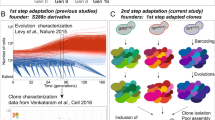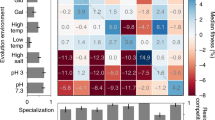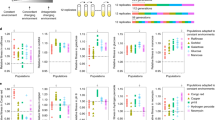Abstract
Trade-offs constrain the improvement of performance of multiple traits simultaneously. Such trade-offs define Pareto fronts, which represent a set of optimal individuals that cannot be improved in any one trait without reducing performance in another. Surprisingly, experimental evolution often yields genotypes with improved performance in all measured traits, perhaps indicating an absence of trade-offs at least in the short term. Here we densely sample adaptive mutations in Saccharomyces cerevisiae to ask whether first-step adaptive mutations result in trade-offs during the growth cycle. We isolated thousands of adaptive clones evolved under carefully chosen conditions and quantified their performances in each part of the growth cycle. We too find that some first-step adaptive mutations can improve all traits to a modest extent. However, our dense sampling allowed us to identify trade-offs and establish the existence of Pareto fronts between fermentation and respiration, and between respiration and stationary phases. Moreover, we establish that no single mutation in the ancestral genome can circumvent the detected trade-offs. Finally, we sequenced hundreds of these adaptive clones, revealing new targets of adaptation and defining the genetic basis of the identified trade-offs.
This is a preview of subscription content, access via your institution
Access options
Access Nature and 54 other Nature Portfolio journals
Get Nature+, our best-value online-access subscription
$29.99 / 30 days
cancel any time
Subscribe to this journal
Receive 12 digital issues and online access to articles
$119.00 per year
only $9.92 per issue
Buy this article
- Purchase on Springer Link
- Instant access to full article PDF
Prices may be subject to local taxes which are calculated during checkout




Similar content being viewed by others
Data availability
All sequencing data are deposited in Short Read Archive under Bioproject ID PRJNA515761. The remaining data are available in either the main text or the Supplementary tables. Figures 2 and 3 have associated raw data. All strains are readily available from the authors upon request.
Code availability
All code used in this manuscript is deposited in GitHub. The source code for computing these fitness estimates can be found at https://github.com/barcoding-bfa/fitness-assay-python. The source code for variant calling and annotation can be found at https://github.com/liyuping927/DNAscope-variants-calling.
References
Loschiavo, S. R. Effect of oviposition sites on egg production and longevity of Trogoderma parabile (Coleoptera: Dermestidae)1. Can. Entomol. 100, 86–89 (1968).
Tinkle, D. W. The concept of reproductive effort and its relation to the evolution of life histories of lizards. Am. Nat. 103, 501–516 (1969).
Reznick, D. A., Bryga, H. & Endler, J. A. Experimentally induced life-history evolution in a natural population. Nature 346, 357–359 (1990).
Stearns, S. C. The Evolution of Life Histories (Oxford Univ. Press, 1992).
Camargo, A., Sarroca, M. & Maneyro, R. Reproductive effort and the egg number vs. size trade-off in Physalaemus frogs (Anura: Leiuperidae). Acta Oecologica 34, 163–171 (2008).
Cunningham, J. T. Degenerative mutations. Nature 130, 203–204 (1932).
Wang, Y. et al. Contribution of both positive selection and relaxation of selective constraints to degeneration of flyability during geese domestication. PLoS ONE 12, e0185328 (2017).
Darwin, C. The Descent of Man, and Selection in Relation to Sex (introduction by Bonner, J.T. & May, R.M.) (Princeton Univ. Press, 1981).
Shoval, O. et al. Evolutionary trade-offs, Pareto optimality, and the geometry of phenotype space. Science 336, 1157–1160 (2012).
Tendler, A., Mayo, A. & Alon, U. Evolutionary tradeoffs, Pareto optimality and the morphology of ammonite shells. BMC Syst. Biol. 9, 12 (2015).
Mooney, K. A., Halitschke, R., Kessler, A. & Agrawal, A. A. Evolutionary trade-offs in plants mediate the strength of trophic cascades. Science 327, 1642–1644 (2010).
Fraebel, D. T. et al. Environment determines evolutionary trajectory in a constrained phenotypic space. eLife 6, e24669 (2017).
Nidelet, T. & Kaltz, O. Direct and correlated responses to selection in a host–parasite system: testing for the emergence of genotype specificity. Evol. Int. J. Org. Evol. 61, 1803–1811 (2007).
Buckling, A., Brockhurst, M. A., Travisano, M. & Rainey, P. B. Experimental adaptation to high and low quality environments under different scales of temporal variation. J. Evol. Biol. 20, 296–300 (2007).
Bono, L. M., Smith, L. B., Pfennig, D. W. & Burch, C. L. The emergence of performance trade-offs during local adaptation: insights from experimental evolution. Mol. Ecol. 26, 1720–1733 (2017).
McGee, L. W. et al. Synergistic pleiotropy overrides the costs of complexity in viral adaptation. Genetics 202, 285–295 (2016).
Jasmin, J.-N. & Kassen, R. On the experimental evolution of specialization and diversity in heterogeneous environments. Ecol. Lett. 10, 272–281 (2007).
Bennett, A. F. & Lenski, R. E. An experimental test of evolutionary trade-offs during temperature adaptation. Proc. Natl Acad. Sci. USA 104, 8649–8654 (2007).
Satterwhite, R. S. & Cooper, T. F. Constraints on adaptation of Escherichia coli to mixed-resource environments increase over time. Evolution 69, 2067–2078 (2015).
Levy, S. F. et al. Quantitative evolutionary dynamics using high-resolution lineage tracking. Nature 519, 181–186 (2015).
Venkataram, S. et al. Development of a comprehensive genotype-to-fitness map of adaptation-driving mutations in yeast. Cell 166, 1585–1596.e22 (2016).
Li, Y. et al. Hidden complexity of yeast adaptation under simple evolutionary conditions. Curr. Biol. 28, 515–525.e6 (2018).
Seedorf, M. & Silver, P. A. Importin/karyopherin protein family members required for mRNA export from the nucleus. Proc. Natl Acad. Sci. USA 94, 8590–8595 (1997).
Rosenblum, J. S., Pemberton, L. F. & Blobel, G. A nuclear import pathway for a protein involved in tRNA maturation. J. Cell Biol. 139, 1655–1661 (1997).
Baccarini, L., Martínez-Montañés, F., Rossi, S., Proft, M. & Portela, P. PKA-chromatin association at stress responsive target genes from Saccharomyces cerevisiae. Biochim. Biophys. Acta Gene Regul. Mech. 1849, 1329–1339 (2015).
Yona, A. H. et al. Chromosomal duplication is a transient evolutionary solution to stress. Proc. Natl Acad. Sci. USA 109, 21010–21015 (2012).
Natesuntorn, W. et al. Genome-wide construction of a series of designed segmental aneuploids in Saccharomyces cerevisiae. Sci. Rep. 5, 12510 (2015).
Sunshine, A. B. et al. The fitness consequences of aneuploidy are driven by condition-dependent gene effects. PLoS Biol. 13, e1002155 (2015).
Garay, E. et al. High-resolution profiling of stationary-phase survival reveals yeast longevity factors and their genetic interactions. PLoS Genet. 10, e1004168 (2014).
Levins, R. Theory of fitness in a heterogeneous environment. I. The fitness set and adaptive function. Am. Nat. 96, 361–373 (1962).
Ehrlich, E., Kath, N. J. & Gaedke, U. The shape of a defense-growth trade-off governs seasonal trait dynamics in natural phytoplankton. Preprint at bioRxiv https://doi.org/10.1101/462622 (2018).
Jessup, C. M. & Bohannan, B. J. M. The shape of an ecological trade-off varies with environment. Ecol. Lett. 11, 947–959 (2008).
Maharjan, R. et al. The form of a trade-off determines the response to competition. Ecol. Lett. 16, 1267–1276 (2013).
Roff, D. A. & Fairbairn, D. J. The evolution of trade-offs: where are we? J. Evol. Biol. 20, 433–447 (2007).
Yi, X. & Dean, A. M. Phenotypic plasticity as an adaptation to a functional trade-off. eLife 5, e19307 (2016).
Sexton, J. P., Montiel, J., Shay, J. E., Stephens, M. R. & Slatyer, R. A. Evolution of ecological niche breadth. Annu. Rev. Ecol. Evol. Syst. 48, 183–206 (2017).
Zhao, L., Liu, Z., Levy, S. F. & Wu, S. Bartender: a fast and accurate clustering algorithm to count barcode reads. Bioinformatics 34, 739–747 (2018).
Kryazhimskiy, S., Rice, D. P., Jerison, E. R. & Desai, M. M. Global epistasis makes adaptation predictable despite sequence-level stochasticity. Science 344, 1519–1522 (2014).
Martin, M. Cutadapt removes adapter sequences from high-throughput sequencing reads. EMBnet. J. 17, 10–12 (2011).
Li, H. Aligning sequence reads, clone sequences and assembly contigs with BWA-MEM. Preprint at https://arxiv.org/abs/1303.3997 (2013).
Freed, D. N., Aldana, R., Weber, J. A. & Edwards, J. S. The Sentieon genomics tools – a fast and accurate solution to variant calling from next-generation sequence data. Preprint at bioRxiv https://doi.org/10.1101/115717 (2017).
Cingolani, P. et al. A program for annotating and predicting the effects of single nucleotide polymorphisms, SnpEff. Fly (Austin) 6, 80–92 (2012).
Acknowledgements
We thank A. Agarwala, G. Kinsler, C. McFarland and D. Fisher for discussions. We thank J. Blundell, K. Geiler-Samerotte, O. Kolodny, S. Kryazhimskiy, C. Li, F. Rosenzweig and S. Venkataram for comments on the manuscript. We thank all members in the Sherlock and Petrov labs for helpful suggestions. Y.L. is supported by the Stanford Center for Computational, Human and Evolutionary Genomics Predoctoral Fellowship. The work was supported by NIH grants (nos. R01 GM110275 and R35 GM131824), a NASA grant (no. NNX17AG79G to G.S.) and a NIH grant (no. R35GM118165 to D.A.P.).
Author information
Authors and Affiliations
Contributions
Y.L., G.S. and D.A.P. were responsible for conceptualization. Y.L. performed the methodology. Formal analysis was carried out by Y.L. Investigation was performed by Y.L. Y.L. wrote the original draft. Y.L., D.A.P. and G.S. undertook the writing, review and editing. Supervision was carried out by D.A.P. and G.S.
Corresponding authors
Ethics declarations
Competing interests
The authors declare no competing interests.
Additional information
Publisher’s note Springer Nature remains neutral with regard to jurisdictional claims in published maps and institutional affiliations.
Supplementary Information
Supplementary information
Supplementary Figs. 1–5.
Supplementary Table 1
Barcode counts of all lineages during the course of evolution.
Supplementary Table 2
Fitness measurements of isolated clones.
Supplementary Table 3
Genetic basis of genome-wide sequenced clones.
Supplementary Table 4
Viability measurement of FPK1 mutants and wild-type strains.
Rights and permissions
About this article
Cite this article
Li, Y., Petrov, D.A. & Sherlock, G. Single nucleotide mapping of trait space reveals Pareto fronts that constrain adaptation. Nat Ecol Evol 3, 1539–1551 (2019). https://doi.org/10.1038/s41559-019-0993-0
Received:
Accepted:
Published:
Issue Date:
DOI: https://doi.org/10.1038/s41559-019-0993-0
This article is cited by
-
Quantifying the local adaptive landscape of a nascent bacterial community
Nature Communications (2023)
-
Extreme Sensitivity of Fitness to Environmental Conditions: Lessons from #1BigBatch
Journal of Molecular Evolution (2023)
-
Fit-Seq2.0: An Improved Software for High-Throughput Fitness Measurements Using Pooled Competition Assays
Journal of Molecular Evolution (2023)
-
Controlling the speed and trajectory of evolution with counterdiabatic driving
Nature Physics (2021)
-
Changes in the distribution of fitness effects and adaptive mutational spectra following a single first step towards adaptation
Nature Communications (2021)



